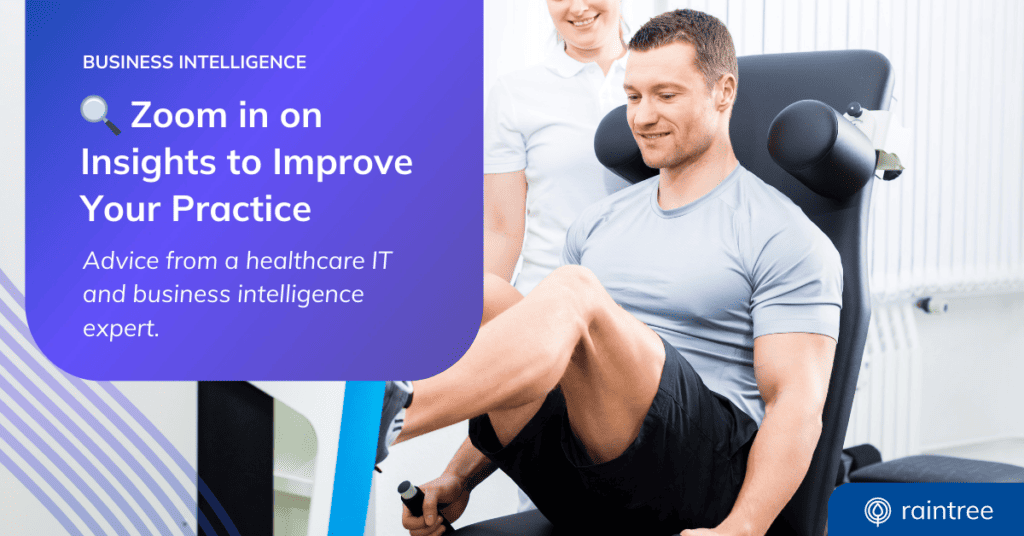Ready to dive into the world of business intelligence (BI) and how it can supercharge your practice?
Recently, we had the pleasure of hosting Bill Sillar, a seasoned healthcare IT and business intelligence expert, on the Therapy Matters podcast. Together, we explored the fascinating realm of BI and its potential to transform your rehab therapy practice from a business perspective. Let’s dig into his key pieces of advice!
What is Business Intelligence?
Therapy practices today are facing lower reimbursements and higher overhead costs. Honestly, making the wrong business decision in this environment can be devastating.
By using intelligent data tools, clinics can make informed and proactive decisions, so that they can keep revenue high and inefficiencies low.
A simple example that Sillar gives to explain BI is by comparing it to the popular Where’s Waldo? book series. Trying to glean information without any assistive technology is like searching for Waldo in a crowd. But in this case, you’re a therapy practice, trying to turn mountains of data into useful insights.
BI tools are like a magnifying glass. They take in your practice’s data, use algorithms to uncover specific trends and potential problems, then highlight it so you can take action.
“That’s what BI is doing: popping Waldo out of that page for you to find the data you need,” says Sillar. “You can catch potential problems early on.”
Where is BI Most Beneficial?
If you’re just getting started with business intelligence tools, you want to be able to demonstrate their value right away.
For that reason, Sillar advises starting with your practice’s financial health. In fact, BI first originated in the financial realm–specifically with banking and stocks. As the field evolved, it opened up specialized business intelligence jobs and courses, and its capabilities expanded into new realms of expertise.
Today, business intelligence tools for healthcare enable clinics to get a 360-degree view of their business. The data can identify and answer questions like:
- How are you gaining top-line revenue?
- Which providers are referring patients to your practice?
- How are patients discovering and choosing your practice?
- Are certain providers no longer referring patients?
These insights can be transformative. For instance, if you notice a decline in referrals from a specific provider, BI empowers you to redirect your marketing efforts accordingly. It’s all about making better-informed decisions, based on real data.
But the power of BI doesn’t stop there. Sillar highlights how missing data in patient onboarding can lead to lost revenue. Business intelligence steps in, revealing gaps in case information or demographic details that may be causing denied claims. By identifying these issues, you can take corrective actions and enhance the patient experience while safeguarding your bottom line.
“Business intelligence can tell you, ‘At this location, you’re always missing this type of information,’” he explains. “And, on the back end, you’re getting denied claims.”
More than Just “Business”—Improving Patient Experiences
For any patient-centered practice, individual experiences and treatment outcomes should always be a top priority. To understand how well your practice is serving its patients, Sillar recommends leveraging business intelligence tools alongside Net Promoter Score (NPS) surveys to gauge patient satisfaction.
NPS + BI = Next Steps
With a simple question on a scale of 1 to 10, you can determine how likely patients are to recommend your services to others. By categorizing “Promoters” (those who rate your practice a 9 or 10) and understanding their reasons for seeking treatment, business intelligence tools enable you to track patterns. For example, if one location excels in shoulder treatment for a particular age group, you can capitalize on this success through targeted marketing or improve performance in other areas.
“If I have one location that’s doing a great job with shoulders for this age group … I’m going to try to get out there and really capture the market.” says Sillar. “If we’re not doing a great job, we can make sure we do some improvement.”
Business Intelligence Expert Advice: Choosing the Right Tool
Now, you might be thinking, “Sounds great, but I’m no SQL expert.”
Fear not! Sillar assures us that there are user-friendly software tools like Power BI, Tableau, Yellowfin, and of course, our personal favorite that bring BI within reach.
What skills do you need for business intelligence in a clinical setting? The good news is, many tools are designed to streamline the technical requirements of the job. Basically, it’s easier than ever to access those insights.
“You don’t need to be a coding expert,” Sillar explains. “You just have to understand what you’re trying to build, and what your end product should be.” (And if you still don’t know where to start, we can help!)
A Business Intelligence Tool Designed for Rehabilitation Therapy
Raintree’s business intelligence tools leverage key financial, operational, and clinical metrics that help you recognize main problem areas, track data trends, and make data-driven decisions.
From financial planning and analysis integration to lead-to-patient reports and conversion days, Raintree’s therapy BI tools are specifically designed with you and your patients in mind.
So why wait? Let’s turn your data into actionable insights, navigate the challenges of our industry with confidence, and propel your practice to new heights. You can become a business intelligence expert in no time!


